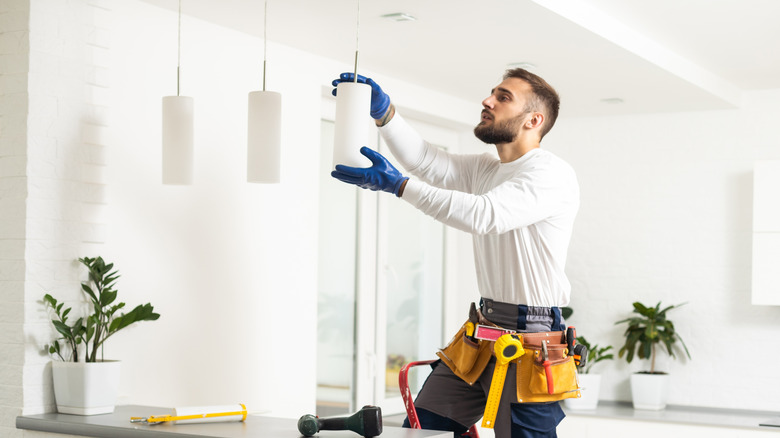LED Lights: Downsides & Safety Precautions To Consider Before Installing
The old adage that "the dose makes the poison" took half a millennium to sink in, but we're starting to get it: Too much of a good thing is a bad thing. And is there anything — aside from political campaigns and celebrity dating updates — that we get more of than LED lighting? These days, we navigate our homes, our workplaces, our computer screens, and our mobile devices, by LED, LED, and more LED.
This has heightened concerns about the known effects of blue light, a major component of LED illumination. The worst of it includes risks of age-related macular degeneration (AMD), photochemical damage to the eyes, disruptions of our sleep, and eye strain. And for some, the parts that aren't the worst feel the worst. Certain people are sensitive to the flicker produced by some LEDs, which can result in problems like headaches and nausea. The flicker problem is a remnant of the transition from incandescent to LED lighting. This has largely been addressed by modern driver and dimmer circuits. If you experience eye strain, headaches, nausea, or even seizures when exposed to certain LEDs in your home, make sure you are using newer, high-quality bulbs and dimmers designed for use with LEDs. The other health risks are a bit more challenging.
The good news is that research consistently shows that LEDs won't damage the healthy eyes of adults during anything like normal usage. That means, thankfully, that concerns about AMD and photochemical damage might be nothing to lose sleep over ... but losing sleep is. In fact, blue light does influence the production of melatonin and can alter circadian rhythms, leading to serious sleep problems.
When it comes to LED lights, the dose makes the poison
There's little question that excessive exposure to high-intensity blue light can cause structural and chemical damage to the eyes. But studies published in Eye, the International Journal of Occupational Safety and Ergonomics, and other journals have established that normal use of LED lighting (as well as phone and tablet screens, for that matter) doesn't present a hazard of chemical and structural problems like AMD.
David J. Ramsey, Director of Ophthalmic Research at the Lahey Hospital & Medical Center (and doubtless an interesting fellow, for all that), wrote in the Harvard Health Blog that the screens of phones, tablets, laptops, and LCD TVs only have, in his words, "negligible" effects on eye health. It turns out that most of the blue light from those devices isn't created by the screens' red, green, and blue LEDs, but by the white backlights — the same sort of lighting in our lamps and fixtures.
On the other hand, research strongly suggests that blue light does stimulate our biological clocks, making a mess of our sleep habits and exacerbating all the mental and physical health concerns that flow downstream from that. Exposure to blue light at the wrong times and in the wrong amounts can lead to lowered levels of melatonin production. Melatonin regulates sleep-wake cycles, and this disruption can result in health effects ranging from mood and behavior problems, to attention deficits, to frequent accidents, and even greater health concerns such as heart disease, high blood pressure, diabetes, and depression.
Stop using LED lights in a way that's ruining your sleep (& use them more safely instead)
Obviously, these sleep-related problems need to be addressed by anyone prone to using bright lighting in the evening... which is just about everyone. And because we don't have much in the way of long-term data about the effects of low-level blue light exposure, it certainly can't hurt to use subtler LEDs and other artificial lights cautiously (we should include incandescent lights here because it turns out the amount of blue light they emit is comparable to LEDs).
So how can you use LEDs in a way that minimizes sleep disruption and any other potential health hazards? Let your natural photophobic response guide your home design. We have evolved mechanisms that make us reject unhealthy light levels, and those responses tend to be minimized by healthy lighting design. Don't position fixtures so that they shine directly toward your eyes, for one — we're looking at you, bathroom lighting! Because intensity is a major factor in the detrimental effects of blue light, diffuse your lighting by bouncing it off of other surfaces.
From there, when designing your LED lighting layout, use dimmers whenever possible; you rarely need your living space to be lighted like a CDC clean room. And turn down the blue by turning up the warmth — that is, using LED lights with warmer color temperatures. Think soft white rather than daylight bulbs. Try to consider your interior lighting in terms of mood, not just quantity of light. And finally, get rid of unnecessary light pollution. All those insistently glowing bits — screens, on-off buttons, clocks, and a hundred more — contribute to your blue light exposure. Design your house so you're not forced to constantly look at them.


